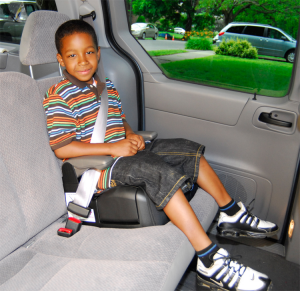
Just as there are many options for buying rear and forward-facing car seats, there are also many options for booster seats. Booster seats come in high-back or backless versions and should be used until a child is at least 9 years old and 4 feet, 9 inches tall.
There should be no urgency to move your child from a forward-facing car seat to a booster seat. You can keep your child in a forward-facing car seat until they reach the seat’s height or weight limit. One reason to delay the move is because forward-facing car seats provide more security, with five points of contact with your child's body compared to three points of contact with a booster. This means a forward-facing car seat has more points of contact to spread crash forces if a collision occurs.
Once your child is ready to move to a booster seat, keep these tips in mind:
Low-back boosters: Also called “backless boosters,” these seats are typically lightweight and more compact. Your child’s ears should not rise above the top of the vehicle seat or head rest.
High-back boosters: Choose this option if your child’s ears rise above the top of the vehicle seat or head rest. This will help prevent whiplash in the event of a collision.
Combination seat: These seats can transform from forward-facing car seat to a booster seat. Again, it is recommended that you keep your child in a forward-facing seating position for as long as possible, to the highest height or weight of that seat, before moving to a booster seat.
Why does my child need a booster?
If your child is not yet at least 4 feet, 9 inches tall, a booster seat will help your vehicle’s seat belt fit your child correctly. The seat belt should fit your child “belt to bone.” This means the seat belt will rest along your child’s chest and collar bone, and across the lap on the hip bones. It should not rest on soft parts of your child’s body, such as the neck or stomach.
Booster seats expire between six and 10 years after their manufacture date. This is because the seats are mainly made from plastics that break down and become brittle over time. Direct sunlight exposure can make them wear out faster. Never purchase a used car seat or booster seat as you will not know the history of the seat (has it been in a crash?) or if there are parts or stickers missing.
Be sure to register your booster seat by filling out the card that came with the seat or registering online with your car seat manufacturer. If you need help, visit the NHTSA website to find your car seat’s manufacturer and online registration page.